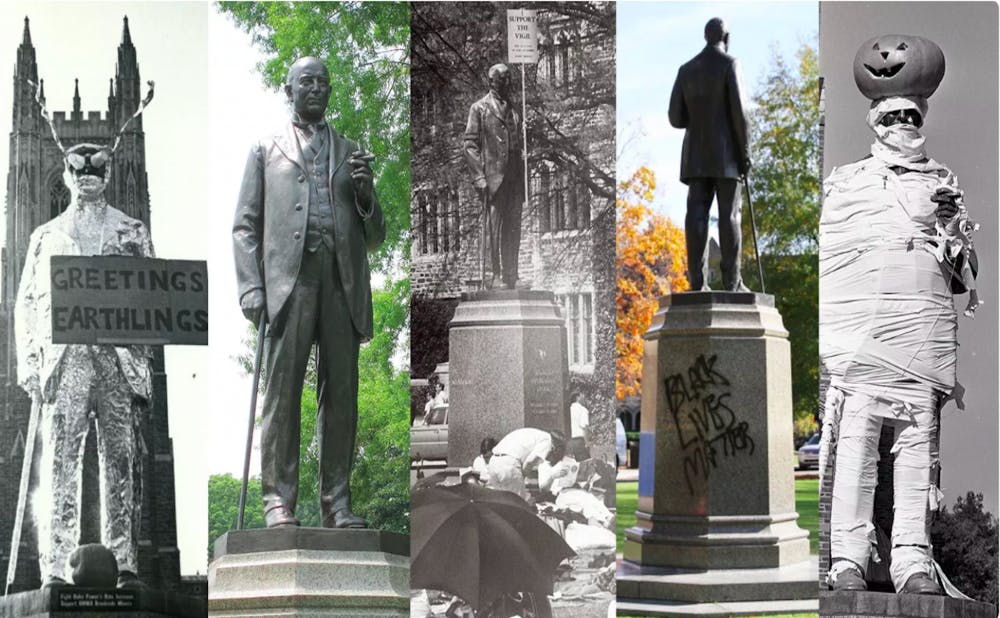While incoming first-year students are visiting during Blue Devil Days, a Wired! Lab project team, “Statues Speak,” will display the first phase of its result to new students and other Duke visitors.
The final products of the project will have two main components, an app and a website with audio files. Each statue on West and East Campus will have a QR code attached to it. Scanning the code with a smartphone will direct the viewers to a website, where they can listen to the stories behind the statue, narrated mostly by members of the Duke and Durham communities. The team is also developing an app called Duke Explore that leads a virtual tour of Duke, starting from West Campus and ending on East Campus. The app will also include three-dimensional models of the statues and audio narratives with accompanying transcripts.
Elizabeth Baltes, assistant professor of visual arts at Coastal Carolina University, organized the project. As a former Ph.D. student at Duke, she was one of the first members of the Wired! Lab when it was launched in the spring of 2009 as a combination of art history and digital technology. Baltes found inspiration for “Statues Speak” in a project in London in which statues on the street told their stories, narrated by celebrities, when the viewers took a picture of the QR codes on the statues. Like London, Duke had numerous statues on campus to which people did not pay enough attention, prompting Baltes to create “Statues Speak” while she was still a student.
Although she originally began working with Duke students, she also got students at Coastal Carolina University to be involved in the project when she became a professor at the school.
“I thought it was important to have students work on this from both angles, because it is a great learning experience for them to collaborate with people from different universities,” Baltes said. “It draws attention to the fact that this is not just an issue about statues at Duke. These are addressing much bigger questions that are of interest to everyone.”
Except for one, which was voiced by a visiting bronze sculptor at Coastal Carolina, all recordings are voiced by members of the Durham community.
“It makes the past present,” Baltes said. “To have a voice of someone who we might see around Durham or on campus gets with the idea that [the statues] are living things.”
Particularly notable among the recordings — along with President Vincent Price and former President Richard Brodhead — is the voice of Provost Sally Kornbluth. Baltes said it was important to have the highest ranking female official at Duke narrate the story of the only statue of a woman, that of a female nurse among the 65th General Hospital Memorial statues near Duke Hospital.
Students also play key roles in the project. Junior Mary Weggeland reviews photos of statues to ensure that the audience sees the best representations of them. With her experiences in using digital tools for art historical research, she has also been working with Baltes and other professors at Duke on adding information about the statues to the database for the Duke Explore app and uploading audio files.
“It really is an all-encapsulating technology that is great for visitors and provides a good experience of seeing Duke’s campus through historical lens of the statuary,” Weggeland said.
Jo Kwon, a masters of computational media student in the Art, Art History and Visual Studies department, has been involved in photographing the 65th General Hospital Memorial statues and turning them into a three-dimensional model.
“I have been seeing so many statues on Duke’s campus, but I never paid attention to them,” Kwon said. “I learn [through the project] more about Duke and Durham’s history overall.”
Looking forward to displaying their results during Blue Devil Days, Baltes and the students involved in the project hoped that viewers would be able to discover the different perspectives behind the stories that each statue told.
“I think viewers have a tendency to want to see portrait statues, because [due to] the nature of portrait statues, they want to see [the statues] as historical records or documents … and forget the idea that statues are not neutral,” Baltes said. “They tend to frame the position of the person who paid for it in a positive way, and I want to draw attention to the idea that statues do tell stories, just like people so, and they are biased, just like people are.”
Get The Chronicle straight to your inbox
Sign up for our weekly newsletter. Cancel at any time.

